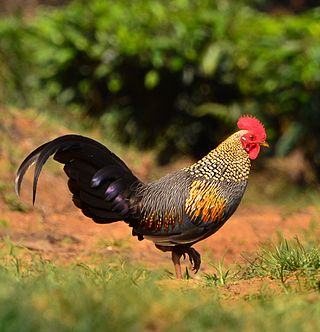
Swans are birds of the genus Cygnus within the family Anatidae. The swans' closest relatives include the geese and ducks. Swans are grouped with the closely related geese in the subfamily Anserinae where they form the tribe Cygnini. Sometimes, they are considered a distinct subfamily, Cygninae.

The American horned owls and the Old World eagle-owls make up the genus Bubo, at least as traditionally described. The genus name Bubo is Latin for owl.

The Gruiformes are an order containing a considerable number of living and extinct bird families, with a widespread geographical diversity. Gruiform means "crane-like".

Anseriformes is an order of birds also known as waterfowl that comprises about 180 living species of birds in three families: Anhimidae, Anseranatidae, and Anatidae, the largest family, which includes over 170 species of waterfowl, among them the ducks, geese, and swans. Most modern species in the order are highly adapted for an aquatic existence at the water surface. With the exception of screamers, males have penises, a trait that has been lost in the Neoaves. Due to their aquatic nature, most species are web-footed.

The bird family Sulidae comprises the gannets and boobies. Collectively called sulids, they are medium-large coastal seabirds that plunge-dive for fish and similar prey. The 10 species in this family are often considered congeneric in older sources, placing all in the genus Sula. However, Sula and Morus (gannets) can be readily distinguished by morphological, behavioral, and DNA sequence characters. Abbott's booby (Papasula) is given its own genus, as it stands apart from both in these respects. It appears to be a distinct and ancient lineage, maybe closer to the gannets than to the true boobies.

The mousebirds are birds in the order Coliiformes. They are the sister group to the clade Cavitaves, which includes the Leptosomiformes, Trogoniformes (trogons), Bucerotiformes, Piciformes and Coraciformes. This group is now confined to sub-Saharan Africa, and it is the only bird order confined entirely to that continent, with the possible exception of turacos which are considered by some as the distinct order Musophagiformes, and the cuckoo roller, which is the only member of the order Leptosomiformes, and which is found in Madagascar but not mainland Africa. Mousebirds had a wider range in the Paleogene, with a widespread distribution in Europe and North America during the Paleocene.

Lambrecht is a town in the Bad Dürkheim district in Rhineland-Palatinate, Germany lying roughly 6 km northwest of Neustadt an der Weinstraße. It is the seat of the like-named Verbandsgemeinde.

Elopteryx is a genus of paravian theropod dinosaur based on fragmentary fossils found in Late Cretaceous rocks of Romania. The single species, Elopteryx nopcsai, was known only from very incomplete material until new specimens were reported in the 21st century. Balaur bondoc might represent a junior synonym of this taxon.
Archaeopsittacus is a genus of prehistoric parrot. It is known from deposits of either Late Oligocene or Early Miocene age at Verreaux near Saint-Gérand-le-Puy, France. A single species, Archaeopsittacus verreauxi, is known.

Burger Lambrechts is a South African shot putter.
Palaeoapterodytes ictus is an extinct species of penguin from the late Oligocene or early Miocene of Argentina, the only member of its genus. Its fossil remains, consisting of only of a severely worn proximal part of a humerus, were found in the Patagonia Formation.

Dasornis is a genus of prehistoric pseudotooth birds. These were probably close relatives of either pelicans and storks or waterfowl; they are placed in the order Odontopterygiformes to account for this uncertainty.
Cruschedula is an enigmatic bird genus considered to be nomen dubium which consists of the single species Cruschedula revola.

Pangalliformes is the scientific name of a provisional clade of birds within the group Galloanserae. It is defined as all birds more closely related to chickens than to ducks, and includes all modern chickens, turkeys, pheasants, and megapodes, as well as extinct species that do not fall within the crown group Galliformes.
Liptornis is a genus of fossil birds of uncertain affinities. The type species is L. hesternus. It was described by Argentine palaeontologist Florentino Ameghino in 1894 from a large cervical vertebra from the Middle Miocene Santa Cruz Formation of Patagonia. At the time, it was referred to the Pelecanidae, though this is questionable. In his 1933 palaeornithological review, Lambrecht referred it only to the superfamily Sulides without placing it in a family. A later study has suggested family Anhingidae.

Christine Lambrecht is a German senior politician of the Social Democratic Party (SPD) who served as the German Federal Minister of Defence in the government of Chancellor Olaf Scholz, from 2021 to 2023. In Chancellor Angela Merkel's administration, Lambrecht previously served as Minister of Justice and Consumer Protection (2019–2021), Minister for Family Affairs (2021) and as one of two Parliamentary State Secretaries at the Federal Ministry of Finance. She previously held various roles within the SPD Parliamentary Group, including as a Deputy Leader and from December 2013 to September 2017 as first parliamentary secretary of the SPD parliamentary group.
Miogallus is an extinct genus of large pheasant that lived during the Miocene of Europe. It contains a single species, Miogallus altus.

Florent "Flor" Jan Maria Lambrechts was a Belgian footballer who played as a forward and midfielder. He played in the First Division for several seasons with Antwerp FC and RCS La Forestoise.

Lambrecht Lambrechts was a Flemish writer and poet. He also published under the pseudonyms RL Doornkapper, Jan van Hasselt and J. Herten.



















